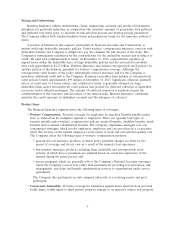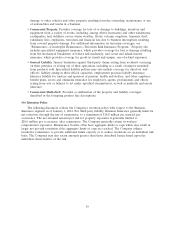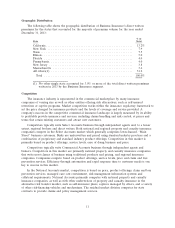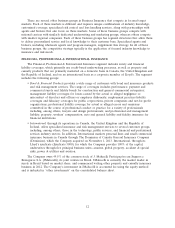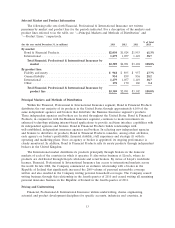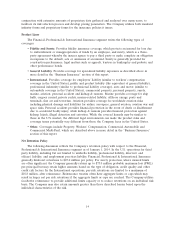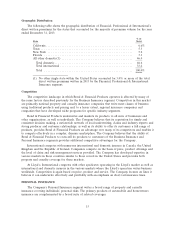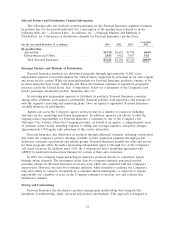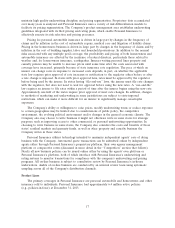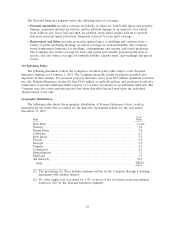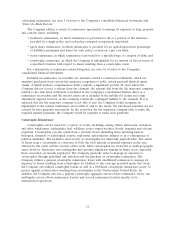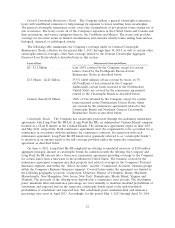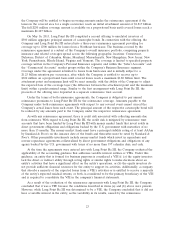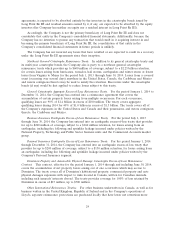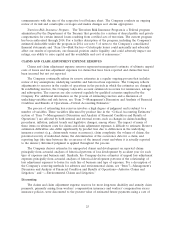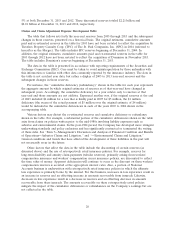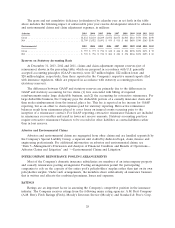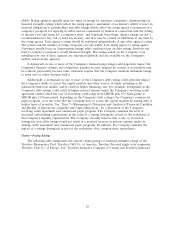Travelers 2013 Annual Report Download - page 29
Download and view the complete annual report
Please find page 29 of the 2013 Travelers annual report below. You can navigate through the pages in the report by either clicking on the pages listed below, or by using the keyword search tool below to find specific information within the annual report.Competition
Although national companies write the majority of this business, Personal Insurance also faces
competition from many regional and hundreds of local companies. Personal Insurance primarily
competes based on breadth of product offerings, price, service (including claims handling), ease of
doing business, stability of the insurer and name recognition. Personal Insurance competes for business
within each independent agency since these agencies also offer policies of competing companies. At the
agency level, competition is primarily based on price, service (including claims handling), the level of
automation and the development of long-term relationships with individual agents. In recent years,
most independent personal insurance agents have begun utilizing price comparison rating technology,
sometimes referred to as ‘‘comparative raters,’’ as a cost-efficient means of obtaining quotes from
multiple companies. Because the use of this technology facilitates the process of generating multiple
quotes, the technology has increased price comparison on new business and, increasingly, on renewal
business. Personal Insurance also competes with insurance companies that use exclusive agents or
salaried employees to sell their products, as well as those that employ direct marketing strategies,
including the use of toll-free numbers and the internet. See ‘‘Item 1A—Risk Factors—The intense
competition that we face could harm our ability to maintain or increase our business volumes and our
profitability.’’
The Agency Automobile line of business has been negatively impacted by various factors, including
the use of price comparison technology by agents and brokers as discussed above. The Company has
undertaken various actions to reduce costs in order to improve underwriting margins and enable it to
have a more competitively-priced product. The Company’s actions in response to these factors include,
among other things, the reduction of certain claim adjustment and other insurance expenses, with the
majority of the impact in the Agency Automobile line of business. The reduction is intended to result
in savings of $140 million pre-tax per year by 2015 when fully implemented. It is also expected to result
in a restructuring charge of approximately $16 million, $12 million of which was incurred in 2013.
Additionally, in the fourth quarter of 2013, the Company launched a new private passenger automobile
product, Quantum Auto 2.0. This product, in addition to incorporating the cost savings described
above, has a lower base commission rate than the Company’s existing Quantum Auto 1.0 product.
These changes in cost structure are intended to enable the Company to price Quantum Auto 2.0 more
competitively while generating an appropriate return. The new product was launched in 18 states by the
end of 2013 and is expected to be offered in all but three states before the end of 2014. The Company
currently intends that, in approved states, all new accounts will be on Quantum Auto 2.0. In addition,
Quantum Auto 2.0 will also be available to agents at their discretion for existing accounts.
CLAIMS MANAGEMENT
The Company’s claim functions are managed through its Claims Services operation, with locations
in the United States and in the countries where it does business. With more than 12,000 employees,
Claims Services employs a diverse group of professionals, including claim adjusters, appraisers,
attorneys, investigators, engineers, accountants, system specialists and training, management and
support personnel. Approved external service providers, such as investigators, attorneys and, in the rare
circumstances when necessary, independent adjusters and appraisers, are available for use as
appropriate.
U.S. field claim management teams located in 21 claim centers and 57 satellite and specialty-only
offices in 45 states are organized to maintain focus on the specific claim characteristics unique to the
businesses within the Company’s business segments. Claim teams with specialized skills, required
licenses, resources and workflows are matched to the unique exposures of those businesses, with local
claims management dedicated to achieving optimal results within each segment. The Company’s home
office operations provide additional support in the form of workflow design, quality management,
information technology, advanced management information and data analysis, training, financial
19


